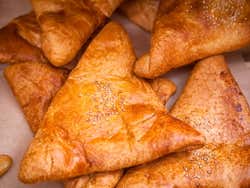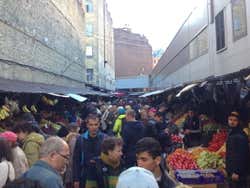
Where to eat in Saint Petersburg
Vodka, caviar, borscht... the list of Russian delicacies goes on! Discover where, when and what to eat during your trip to Saint Petersburg.
Saint Petersburg's restaurants, bars and cafes have dishes to suit all tastes and budgets, allowing everyone to sample the best of Russian cuisine! With a wealth of flavours reflecting the multiculturalism of the country, St Petersburg's gastronomy is based in simple and tasty ingredients that can survive cultivation in an extremely cold climate. We've compiled a list of some of the top Russian delicacies so you can decide what try during your trip!
What to eat in Saint Petersburg?
- Borscht: the iconic beetroot soup, beloved across Slavic countries.
- Pelmeni: Eastern Europe is well known for its dumplings, and Russian pelmeni stand out for their semi-circular shape and super-thin dough stuffed with minced meat, onion and herbs.
- Vareniki: also called pierogi, these filled dumplings can be sweet or savoury: think potato, sauerkraut, minced meat and or cheese, or various fruits, all generally served with sour cream.
- Blini: traditional wafer-thin Russian pancakes made from wheat or buckwheat flour. They're eaten savoury (with caviar and sour cream, for example) or sweet (with jam and sour cream) and served folded or rolled up on your plate.
- Olivier salad: known elsewhere in the world as Russian salad, this is a mix of chopped chicken or ham, mixed with potatoes, eggs, peas and mayonnaise.
- "Self pod shuboy" ("herring in a fur coat"): another popular salad for Russians, this is a colourful dish of herring, beets and potatoes.
- Beef Stroganoff: like many main dishes in Saint Petersburg, the world-famous Stroganoff (named after a Russian noble family) is heavy and meaty. The sautéed beef in a sour cream sauce is usually served with rice. Other popular mains include shashlyk (kebabs) and zharkoye (hot pot), great for warming you up if you visit in winter!
- Smetana: as you might have guessed, the Russians love their sour cream, known as smetana: it goes on everything, from soup to blinis!
- Caviar: ikra, as it's called in Russia, was traditionally the snack of the Tsars and the rich. It is still expensive, especially if you buy black caviar from the beluga sturgeon, although red salmon caviar is cheaper. It's eaten on buttered bread and washed down with vodka or champagne!
- Kvass: a fermented non-alcoholic beverage made from rye bread, and often flavoured with fruits or herbs.
- Vodka: the iconic Russian drink tastes different here. It's drunk as a shot and often chased down with a pickle, and if you're pouring the drinks, you make the toast. Za zdorovie!
Where to eat in Saint Petersburg?
So you know what you're going to eat, now where's best to try it? You'll find any number of self-service style restaurants around the city, which have the advantage that you can point to the foods you want, avoiding the language barrier. In other places, you'll probably have to hope they have an English menu and that it makes sense!
Cheap and reliable chains include Stolle for pies, Bushe for coffee and cakes, and Baltic Bread for sandwiches and pastries. If you want a basic but authentic Russian meal with the locals, head to a "stolovaya", canteens leftover from the Soviet days.
St Petersburg has a wide range of both Russian and international offerings when it comes to cafes and restaurants, and now has an ever increasing number of decent vegetarian options too. In particular, Nevsky Prospect and its surroundings are one of the areas with the highest number of restaurants and cafes.
In most restaurants in St. Petersburg, as in most museums, shops and places of interest in the city, it is possible to pay by credit card even if they are places with very cheap prices.
When to eat in Saint Petersburg?
In Russia, mealtimes are relatively extended. Restaurants in Saint Petersburg are usually open between midday and 4 pm for lunch, and between 6 pm and 11 pm for dinner, although you'll probably find a fair few places that are open for 24 hours.

